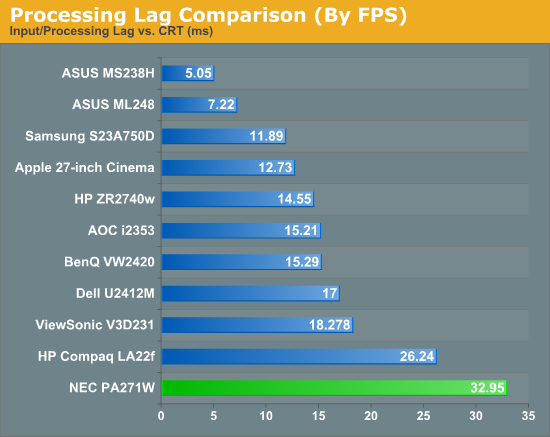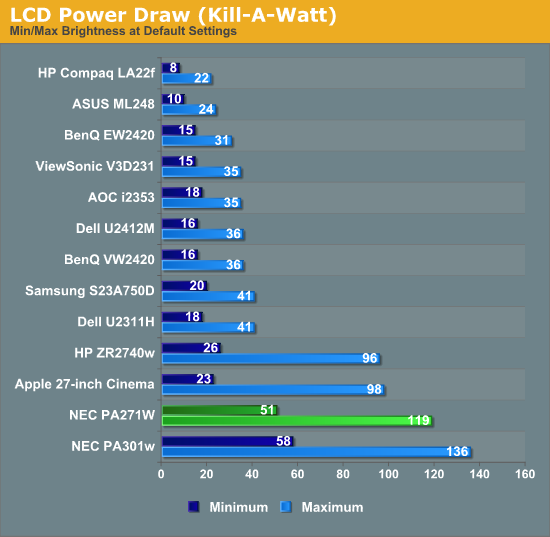NEC PA271W - When Accuracy and Consistency Matter
by Chris Heinonen on May 1, 2012 1:55 PM ESTNEC PA271W - Input Lag and Power Use
The last 27” display I tested, the HP ZR2740w, was a pleasant surprise for gaming as it had a very low lag time despite the IPS panel and high resolution, likely due to the lack of an internal scaler or LUT to add a delay. Since the NEC has a scaler, and the additional custom electronics to provide display uniformity, I wasn’t certain that the NEC would perform as well.

As you can see, the NEC is not going to be a display for a serious gamer, though it really isn’t targeting that market either. The input lag was 20.5 ms, and the pixel response took 24.9 ms to go from blue to yellow to blue, giving us an overall response time of 32.95 ms. The effective (subjective) lag was a little better, but with that high input lag it was still close to 25 ms, which is more than most serious gamers would be interested in. If you want a 27”, 2560x1440 resolution display for gaming the HP is still your best option.
The PA271W has a built in power use monitor showing you how much power you are using with the display, so being efficient is something that it does aim to do. With the backlight set at minimum we used 51 watts, and at maximum we used 119 watts. These were both worse than the HP as well, but since the HP uses an LED lighting system we would expect it to come in behind. Since the LED lighting system provided for a smaller gamut than the NEC's CCFL system produced, and a less uniform screen, I’m certain that had something to do with NEC's decision to stay with the CCFL technology on this panel. Power use wasn’t bad, it just wasn’t exceptional, and any 27” display is going to use far more power than a 24” or smaller one.











69 Comments
View All Comments
sviola - Wednesday, May 2, 2012 - link
If it wasn't for LCDs, probably no one would have monitors/tvs bigger than 30" (and a CRT that size was huge and extremely heavy).DanNeely - Wednesday, May 2, 2012 - link
Rear projection TVs got into the 50/60" class.Mumrik - Wednesday, May 2, 2012 - link
And 32" was the standard size for a widescreen TV in the living room around here...ctbaars - Wednesday, May 2, 2012 - link
I remember the same kind of argument when we went from Vinyl to CD :/ I'm not quite buying it.Mumrik - Wednesday, May 2, 2012 - link
I'm still using a Sony FW900.To be honest, it's not in tip-top shape anymore - the picture could be sharper. I had hoped to be able to use it until OLED arrived in the mainstream (as it was supposed to do YEARS ago). At this point I'm starting to consider 24-27" IPS panels.
JohnMD1022 - Wednesday, May 2, 2012 - link
My NEC Multisync FE992 still performs flawlessly.When it begins to fail, I'll replace it.
Meanwhile, with each passing day, LCD technology improves and prices drop. :)
futrtrubl - Tuesday, May 1, 2012 - link
The numbers seem off for a couple of the displays with their minimum brightness settings drawing MORE power. That's the two NECs, the Apple and a Dell and BenQ.JarredWalton - Tuesday, May 1, 2012 - link
You are correct, sir! I've updated the chart so that the colors and min/max values are now correct.cheinonen - Tuesday, May 1, 2012 - link
Sorry about that, they got flipped in a version of the spreadsheet I use for the numbers and I thought they were fixed in the most recent one, but I'll update that again so it doesn't happen next time.asasa45454 - Tuesday, May 1, 2012 - link
Are you going to review them? They have input lag ~10ms, 2560x1440.